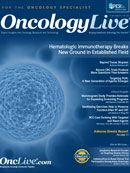Publication
Article
Oncology Live®
Mammogram Study Provides Rationale for Expanding Screening Programs
Author(s):
Most deaths from breast cancer occur in women who have not been regularly screened and whose tumors are diagnosed at a median age 49 years, confirming the need for the greater use of annual mammography in younger women, according to a recent study that marks the latest episode in the debate over screening guidelines.
Massimo Cristofanilli, MD
Director, Breast Care Center
Jefferson University Hospitals
Philadelphia, PA
Most deaths from breast cancer occur in women who have not been regularly screened and whose tumors are diagnosed at a median age 49 years, confirming the need for the greater use of annual mammography in younger women, according to a recent study1 that marks the latest episode in the debate over screening guidelines.
The oncology community has reacted to the report from researchers at Massachusetts General Hospital (MGH) and colleagues at Harvard Medical School and its affiliates with calls for adherence to guidelines endorsed by medical associations as opposed to federal recommendations.
Massimo Cristofanilli, MD, director of the Breast Care Center, at Jefferson University Hospitals in Philadelphia, said in an interview that these new data should help the oncology community increase patients’ access to screenings. He did not endorse a particular screening program regarding age at first mammogram or schedule, although he said this study reinforces the value of mammograms and the need for screening programs.
“We need to put our efforts into trying to have more screening mammogram programs,” said Cristofanilli. “If we move in that direction, there will be fewer and fewer patients with advanced disease.”
Some cancer centers already are taking such steps. The Seattle Cancer Care Alliance has launched a public health campaign aimed at simplifying recommendations of the American Cancer Society (ACS) for breast cancer prevention and screening, including the suggestion that women ages 40-69 years undergo annual mammograms and clinical breast exams.
Responding to the research report in September, the American College of Radiology said in a statement that the findings support the guidelines that the group endorses, in concert with the ACS and the American Congress of Obstetricians and Gynecologists.
To conduct the study, Webb et al examined the records of 7301 women diagnosed with stages I-III invasive breast cancer from January 1990 through December 1999 and followed through 2007 at MGH and Brigham and Women’s Hospital, both part of the Partners HealthCare system in the Boston area. The study population was narrowed to 1705 patients whose records were complete and whose cause of death could be confirmed.
The researchers defined biennial screening as mammography performed at intervals ≤2 years in the absence of signs or symptoms such as abnormal lymph node findings or complaints.
Of the 609 deaths in the study group attributable to breast cancer, 70.9% (n = 431) were among the estimated 20% of women who were not screened. This group included patients who had not been screened in more than 2 years (6%) or were never screened (65%). The remaining 29.2% of patients (n = 178) who died had been screened, with 19.4% screen-detected cancers and 9.9% true interval cancers.
Median age at diagnosis of fatal breast cancers was 49 years, while the median age was 72 years in deaths not from breast cancer.
As expected, women who died of breast cancer and were unscreened presented with worse prognostic factors such as median tumor diameter, grade, and rate of lymph node metastasis—clinical features that would be better addressed through earlier detection.
“Our study emphasizes that palpable breast cancers remain the major challenge to efforts to reduce breast cancer mortality,” the researchers wrote. “Although palpable breast cancers still occur as interval cancers among who women who have undergone screening, palpable or symptomatic cancers account for essentially all deaths in women who have not attended screening.”
Currently, breast cancer screening recommendations for women at average risk differ (Table). The US Preventive Services Task Force (USPSTF), which recommends starting screenings later in life and at longer intervals, based its recommendation partly on data showing a marginal decrease in breast cancer mortality through screening programs.2 Models predict the probability of developing breast cancer over a woman’s lifetime starting at age 40 ranging from 12-15% in an unscreened population, according to an article supporting the recommendation.3 In an unscreened population, the median probability of dying from breast cancer after age 40 is 3.0%.
Table. Breast Cancer Screening Recommendations for Women at Average Risk
American Cancer Society
National Cancer Institute
National Comprehensive Cancer Network
US Preventive Services Task Force
Every year starting at age 40
Every 1-2 years starting at age 40
Every year starting at age 40
Informed decision-making with health care provider ages 40-49, followed by every 2 years ages 50-74
Webb et al, however, contend that the USPSTF recommendation and supporting material underestimate the effectiveness of screening mammography and that an understanding of the true benefit of mammography is critical.
The ongoing debate over age at first mammography screening and frequency has caused confusion for both physicians and patients, noted Cristofanilli. “I’ve heard many times from oncologists or primary physicians that because of the different guidelines, they have instituted different recommendations for their patients,” he said.
References
- Webb ML, Cady B, Michaelson JS, et al. A failure analysis of invasive breast cancer: most deaths from disease occur in women not regularly screened. Cancer. Published online ahead of print September 9, 2013. doi: 10.1002/cncr.28199.
- US Preventive Services Task Force. Screening for breast cancer: US Preventive Services Task Force recommendation statement. Ann Intern Med. 2010;152(10):716-726.
- Mandelblatt JS, Cronin KA, Bailey S, et al. Effects of mammography screening under different screening schedules: model estimates of potential benefits and harms. Ann Intern Med. 2009;151(10):738-747.










